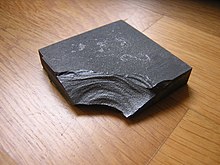
| |
| Names | |
|---|---|
| IUPAC name
Boron carbide
| |
| Other names
Tetrabor
| |
| Identifiers | |
3D model (JSmol)
|
|
| ChemSpider | |
| ECHA InfoCard | 100.031.907 |
PubChem CID
|
|
| UNII | |
CompTox Dashboard (EPA)
|
|
| |
| |
| Properties | |
| B4C | |
| Molar mass | 55.255 g/mol |
| Appearance | dark gray or black powder, odorless |
| Density | 2.50 g/cm3, solid.[1] |
| Melting point | 2,350 °C (4,260 °F; 2,620 K)[1] |
| Boiling point | >3500 °C[1] |
| insoluble | |
| Structure | |
| Rhombohedral | |
| Hazards | |
| Safety data sheet (SDS) | External MSDS |
| Related compounds | |
Related compounds
|
Boron nitride |
Except where otherwise noted, data are given for materials in their standard state (at 25 °C [77 °F], 100 kPa).
| |
Boron carbide (chemical formula approximately B4C) is an extremely hard boron–carbon ceramic, a covalent material used in tank armor, bulletproof vests, engine sabotage powders,[2] as well as numerous industrial applications. With a Vickers hardness of >30 GPa, it is one of the hardest known materials, behind cubic boron nitride and diamond.[3]
- ^ a b c Haynes, William M., ed. (2016). CRC Handbook of Chemistry and Physics (97th ed.). CRC Press. p. 4.52. ISBN 9781498754293.
- ^ Gray, Theodore (2012-04-03). The Elements: A Visual Exploration of Every Known Atom in the Universe. Black Dog & Leventhal Publishers. ISBN 9781579128951. Retrieved 6 May 2014.
- ^
"Rutgers working on body armor". Asbury Park Press. Asbury Park, N.J. August 11, 2012. Retrieved 2012-08-12.
... boron carbide is the third-hardest material on earth.